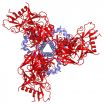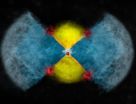NIH-supported scientists unveil structure, dynamics of key HIV molecules
Findings could aid design of HIV vaccines, treatments
2014-10-08
(Press-News.org) New research has illuminated the movement and complete structure of the spikes on HIV that the virus uses to bind to the cells it infects. This research, led by scientists at the National Institutes of Health, Weill Cornell Medical College and Yale University School of Medicine, could help advance efforts to develop HIV vaccines and treatments.
Three sets of a pair of molecules called gp120 and gp41 constitute each HIV spike, which adopts different configurations before and after the virus fuses with a cell. The atomic-level structures of pre-fusion gp120 and post-fusion gp120 and gp41 had been determined previously. After more than a decade of studies, the new research completes the picture by describing the atomic-level structure of the entire pre-fusion gp41. Now it is evident how the whole spike rearranges itself when the virus fuses with a cell, and the ways HIV evades detection by the immune system are clearer.
The researchers also used a sophisticated technique to see how the spike moves before and during cell binding. They found that the unbound spike rapidly shifts among three different configurations. The predominant form, dubbed the closed or ground state and described in the new atomic-level structure, is difficult for the immune system to see, and only broadly neutralizing antibodies bind to it. In this form, the spike attaches well to only one of the two cellular receptors that HIV must bind to fuse with a cell. When broadly neutralizing antibodies and entry-inhibiting drugs bind to HIV, they often stabilize the spike in the ground state and thereby prevent the virus from infecting a cell.
Taken together, the scientists say, the findings indicate that an effective HIV vaccine that teaches the immune system to neutralize the virus should be based on the ground-state, pre-fusion form of the spike. Knowing the atomic structure of that configuration now gives researchers the tools to design and manipulate such a vaccine component.
INFORMATION:
Researchers
Anthony S. Fauci, M.D., director of the National Institute of Allergy and Infectious Diseases (NIAID); Peter D. Kwong, Ph.D., chief of the Structural Biology Section and Structural Bioinformatics Core at the NIAID Vaccine Research Center; and Jason Gorman, Ph.D., research fellow in the Structural Biology Section at the NIAID Vaccine Research Center, are available for comment.
NIAID conducts and supports research—at NIH, throughout the United States, and worldwide—to study the causes of infectious and immune-mediated diseases, and to develop better means of preventing, diagnosing and treating these illnesses. News releases, fact sheets and other NIAID-related materials are available on the NIAID Web site at http://www.niaid.nih.gov.
About the National Institutes of Health (NIH)
NIH, the nation's medical research agency, includes 27 Institutes and Centers and is a component of the U.S. Department of Health and Human Services. NIH is the primary federal agency conducting and supporting basic, clinical, and translational medical research, and is investigating the causes, treatments, and cures for both common and rare diseases. For more information about NIH and its programs, visit http://www.nih.gov/.
To schedule interviews, please contact Laura S. Leifman.
Citation
Munro et al. Conformational dynamics of single HIV-1 envelope trimers on the surface of native virions. Science DOI: 10.1126/science.1254426 (2014).
Pancera et al. Structure and immune recognition of trimeric prefusion HIV-1 Env. Nature DOI: 10.1038/nature13808 (2014).
NIH...Turning Discovery Into Health®
[Attachments] See images for this press release:

ELSE PRESS RELEASES FROM THIS DATE:
2014-10-08
NEW YORK — (October 8, 2014) -- Researchers at Weill Cornell Medical College have developed technologies that allow investigators, for the first time, to watch what they call the "dance" of HIV proteins on the virus' surface, which may contribute to how it infects human immune cells. Their discovery is described in the Oct. 8 issue of Science, and is also a part of a study published the same day in Nature.
The new technology platform opens new possibilities for devising an approach to prevent HIV infection, says Dr. Scott Blanchard, an associate professor of physiology ...
2014-10-08
Astronomers have discovered a black hole that is consuming gas from a nearby star 10 times faster than previously thought possible. The black hole—known as P13—lies on the outskirts of the galaxy NGC7793 about 12 million light years from Earth and is ingesting a weight equivalent to 100 billion billion hot dogs every minute.
The discovery was published today in the journal Nature.
International Centre for Radio Astronomy Research astronomer Dr Roberto Soria, who is based at ICRAR's Curtin University node, said that as gas falls towards a black hole it gets ...
2014-10-08
An international team of astronomers has been able to see into the heart of an exploding star, by combining data from telescopes that are hundreds or even thousands of kilometres apart. Their results are published at 18:00 hours on Oct 8 2014 in the journal Nature.
Highly-detailed images produced using radio telescopes from across Europe and America have pinpointed the locations where a stellar explosion (called a nova), emitted gamma rays (extremely high energy radiation). The discovery revealed how the gamma-ray emissions are produced, something which mystified astronomers ...
2014-10-08
This news release is available in German. A team of ETH Zurich researchers led by professors Nenad Ban and Ruedi Aebersold have studied the highly complex molecular structure of mitoribosomes, which are the ribosomes of mitochondria. Ribosomes are found in the cells of all living organisms. However, higher organisms (eukaryotes), which include fungi, plants, animals and humans, contain much more complex ribosomes than bacteria. In eukaryotes, ribosomes can also be divided into two types: those in the cytosol – which comprises the majority of the cell – and ...
2014-10-08
(PHILADELPHIA) – Transfer RNAs (tRNAs) are ancient workhorse molecules and part of the cellular process that creates the proteins, critical building blocks of life that keep a cell running smoothly. A new discovery suggests that the number of human genomic loci that might be coding for tRNAs is nearly double what is currently known. Most of the newly identified loci resemble the sequences of mitochondrial tRNAs suggesting unexpected new links between the human nuclear and mitochondrial genomes, links that are not currently understood.
Transfer RNAs (tRNAs) represent ...
2014-10-08
CORVALLIS, Ore. – A study of the removal of two dams in Oregon suggests that rivers can return surprisingly fast to a condition close to their natural state, both physically and biologically, and that the biological recovery might outpace the physical recovery.
The analysis, published by researchers from Oregon State University in the journal PLOS One, examined portions of two rivers – the Calapooia River and Rogue River. It illustrated how rapidly rivers can recover, both from the long-term impact of the dam and from the short-term impact of releasing stored ...
2014-10-08
Alexandria, Va. — When Francisco Pizarro landed in Peru in 1532, his band of Spanish conquistadors set off a chain of far-reaching consequences for the people and economics of western South America. The Chira Beach-Ridge Plain in northwestern Peru is rippled by a set of nine ridges — several meters tall by up to 300 meters wide and 40 kilometers long, and large enough to be visible from space — running parallel to the shoreline. The pattern, observed along at least five other Peruvian beaches, was thought to have formed naturally over the past 5,000 years. ...
2014-10-08
Reports of insomnia are common among the elderly, but a new study finds that sleep problems may stem from the quality of rest and other health concerns more than the overall amount of sleep that patients get.
An estimated 30 percent of adults report having some symptoms of insomnia, which includes difficulty falling asleep, staying asleep or waking up too early and then not feeling well rested during the daytime. Prior studies suggest that nearly half of older adults report at least one insomnia symptom and that lack of restorative sleep might be linked to heart disease, ...
2014-10-08
As the effects of a changing climate become acute, organizations charged with overseeing refuge areas must take action to adapt. The US Fish and Wildlife Service (USFWS) maintains the National Wildlife Refuge System, which constitutes world's largest system of protected lands and waters. According to a November BioScience article by Robert Fischman and Vicky Meretsky of Indiana University and their coauthors, the service may not always be adequately planning for an altered future, but best practices from several plans point the way for improvement. For instance, existing ...
2014-10-08
Using a high-throughput screening assay, EPFL scientists have discovered two small molecules that could overcome the multidrug resistance of the bacterium that causes tuberculosis.
Tuberculosis is an infectious disease caused by a bacterium called Mycobacterium tuberculosis (Mtb), which commonly infects the lungs. In 2012, the World Health Organization estimated that tuberculosis affected 8.6 million people worldwide, causing death in 1.4 million. However, the fight against the disease is hampered by the fact that treatment requires a long time and that Mtb often develops ...
LAST 30 PRESS RELEASES:
[Press-News.org] NIH-supported scientists unveil structure, dynamics of key HIV molecules
Findings could aid design of HIV vaccines, treatments



